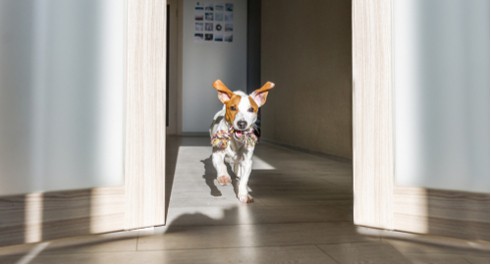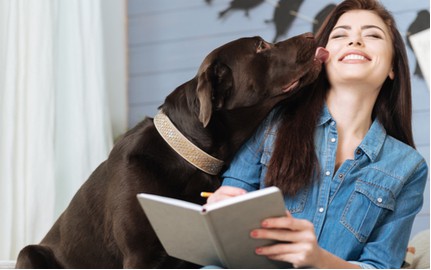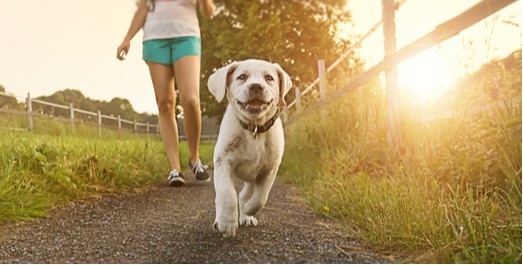Zoomies are normal and can happen for several reasons:
- Your dog still has energy left after their walk
- Their walk may not have been long enough
- They might be happy
- They may have been restricted to being on the leash, so they’re unable to run to burn off their energy
Oh boy… the zoomies. Make sure you stand well back when these happen. Fast, frenetic, yet fun to watch; these action-packed moments can occur anytime. Mostly when you least expect it.
From young puppy to fully-grown dog, get ready – it could be happening in a room near you soon.
Zoomies Are Normal and Nothing to Worry About
All dogs need exercise. One of the best ways to do it is to take them for a regular walk. Some dogs need more exercise than others, but they’re all prone to a case of the zoomies.
Dog zoomies after a walk are common and don’t usually point to an issue. Our dog sometimes – but not always – does this. It might seem odd, but the longer the walk we take her on, the more likely she is to zoom around when we get back home. Maybe she’s glad to be home?
Zooming around without stopping is part of a dog’s behavior. This isn’t a medical condition. Of course, if your dog does this a lot, you should figure out why.
I’m going to share some tips and advice on finding solutions for excessive zoomies after a walk.
Top tip: Stand aside for safety until your dog has finished
I suggest this for safety’s sake. Here’s why:
- A large dog could knock you off your feet.
- A small dog could get under your feet, achieving the same outcome and possibly hurting the dog too.
Don’t Try to Stop the Behavior

As crazy as it might look to you, your dog is doing something natural.
You probably have times when you want to get out of the house and go for a long walk or a run in the fresh air. You feel restless and want to burn off some energy. You know enough not to do it in the house, though.
Your dog doesn’t know that.
They’ll happily run around under the table, through the house, and even outside to get rid of that energy.
And you shouldn’t try and stop them either. Let them get it out of their system.
Essential safety tip: Don’t join in
Your dog is having fun, so it seems logical that you might want to have some fun with them. It’s the last thing you should do though.
Your dog will likely think you’re joining in with the fun. They’ll be encouraged to do it more.
Instead, you need to be able to control the situation by recalling your dog if necessary. This shouldn’t be needed in the house, but if your dog gets the zoomies after a walk when you return to your car to go home, you do need to make sure you can catch them.
Have a pocketful of treats and practice recall with them as often as you can. They should return to you when you use a specific word such as “Come!” They’ll soon learn that doing so will likely result in a treat.
In other situations where safety isn’t a concern, let them blow out that last bit of energy.
Make a Note of When They Acted Like This to Identify a Pattern

Do this straight away as it can help build a picture of how often your dog does zoomies after a walk. Make sure you note down the following things:
- Time of day
- The weather
- How long the zoomies lasted for
- How long the walk lasted for before the behavior started
- Anything else that could be relevant to identify a pattern, i.e., food or location
We did this and found out that Freya, our Bichon Frise, only ever did it after a shorter walk. She adores walking – she’s always been happy to go on hikes through forests, through mud, through sand… you name it, she’s there having fun.
But we couldn’t figure out why some walks resulted in zoomies, and others resulted in her napping for a few hours afterward. We figured out from our notes that a walk of less than two or three miles was far more likely to result in a case of the zoomies shortly after we got home.
The weather didn’t seem to make much difference, although she is slightly more prone to going mad if it has been raining and she’s been toweled off.
That said, a hike with steeper inclines always wears her out more than a walk on a flat surface, even if the latter walk is longer. Makes sense – it does the same for us, too!
Dog Zoomies Never Last Long
Fortunately! Oftentimes, our dog can wear herself out in 30 seconds or so. But even if your dog goes crazy for longer and zooms around the house or garden, you should find they stop within two or three minutes.
Some people have said their dogs do it after every walk regardless of how long they’re out for. Others have said it only occurs after a short walk, but only then for a few moments before they fall asleep.
The most important thing to glean from this is that all dogs are different. There’s no need to worry if your puppy does it a lot and then never does it again once they are fully grown, for example.
Zoomies After Walks Are More Likely to Occur With Puppies
Puppies have boundless energy, yet you cannot take them for long walks until they’re older. They need to properly develop first. That makes zoomies more likely to occur.
A good way to reduce them happening is to go for two short walks per day rather than one. Walks are ideal for tiring out your pup, but don’t overdo it with a long-distance trek. They won’t be ready for it.
Indoor playtime sessions help manage their energy levels too. That gives you the chance to minimize the zoomies when they do get back from a walk.
Mind games, such as those played with treats that test their intelligence, tire them out too. Try it if increased walking doesn’t resolve the zoomies.
Make Sure They Can Safely Enjoy Zoomies Indoors and Outdoors
Keeping your pooch safe is vital. Some dogs have a favorite place to do this. For example, we have a galley kitchen with a couple of non-slip runners along it.
She loves zooming around on those and skidding off the end, so she then slides on the tiled floor. When she stops, she turns around and does the same in the opposite direction.
Crazy!
Fun to watch, and thanks to the non-slip runners, she’s safe, too. But we make sure nothing is sitting on the floor that she could crash into that would cause her harm.
Look around your home and make sure the areas your dog most commonly goes crazy in like this, are safe for them. It could save you an expensive trip to the vet.
Excessive Zoomie Episodes Might Mean Longer Walks Are Needed

Dogs will try and burn off excess energy whenever they have it. Bombing around like a lunatic is the ideal way to do this. (Hey, it works for me too, on occasion.)
I suggested making notes on when the behavior happens, so you can work out a pattern. This helps you identify how often it happens, as you may not realize it’s a frequent thing unless it’s written down in black and white in front of you.
If you find your dog is zooming after walks several times a week, think about extending the walking you’re doing.
We find Freya is better having one long walk a day rather than two shorter ones. She’s settled after a long early morning walk.
That might suit your dog too, especially if they spend time alone during the day.
Top Reasons Why Your Dog Might Be Zooming Around After Going Out
If you want to figure out why your dog zooms around after a walk they may:
- Have met or played with a doggy friend
- Still have some energy left to get rid of
- Have spent a long time indoors and they’re delighted to be out
- Be an energetic breed and thus need more exercise
- Simply be happy!
Our dog exhibits this behavior more often if she’s been for a walk on the leash.
If we visit somewhere safe where we can let her off the leash, she can charge around and get rid of her energy. That means no zoomies when we get home.
If we can’t let her off the leash – maybe we’ve just gone for a walk in the neighborhood – zoomies are more likely to happen.
Only Excessive Zoomies Are Anything to Be Concerned About
These could indicate your dog isn’t getting enough exercise.
An increase in the distance you walk your dog or the number of times you take them out each day would likely solve the issue. If your dog has a ton of energy to get rid of, zoomies are more likely to happen.
Find a walking schedule that works for you and your dog. Keep making those notes to see if the zooming episodes are reduced. They probably won’t completely disappear, but you’ll likely find they’re shorter when they do occur.

Sources:
https://www.akc.org/expert-advice/health/puppies-how-much-exercise/
https://www.dogster.com/dog-training/dog-zoomies
https://www.akc.org/expert-advice/lifestyle/what-are-zoomies/
https://www.reddit.com/r/puppy101/comments/a344bi/zoomies_after_walk/
https://www.dogster.com/lifestyle/is-your-dog-going-crazy-they-may-have-a-case-of-the-zoomies
https://www.southbostonanimalhospital.com/blog/why-your-dog-gets-the-zoomies

